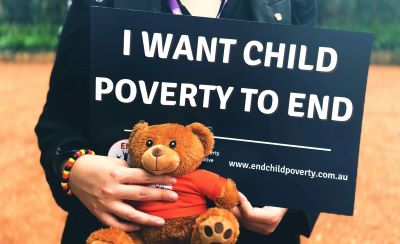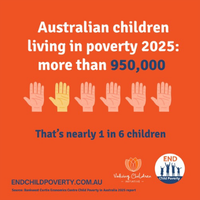End Child Poverty Report
 Almost One Million Australian Children Living in Poverty
Almost One Million Australian Children Living in Poverty
New data from the “Child Poverty in Australia 2025” report, released on Tuesday by the Bankwest Curtin Economics Centre and the Valuing Children Initiative for the End Child Poverty campaign, revealed more than 950,000 Australian children are experiencing food insecurity, poor housing conditions, and limited access to education and healthcare driven by rising housing costs, widening inequality and a failure of income support to keep pace with inflation.
It will be a harsh Christmas for hundreds of thousands of children who are in poverty. Our Church agencies do much to alleviate poverty but this is a structural issue, a systemic injustice that requires public policy and political will to prioritise lifting children out of poverty”, said Liz Stone, General Secretary of the National Council of Churches in Australia.
Almost a quarter of a million children have been plunged into poverty in just four years – a 33% increase – prompting advocates across Australia to call for urgent legislation to define and measure the impacts of poverty on childhood wellbeing.
“Poverty shapes a child’s life. Some tell us they’re punished for wearing torn uniforms they can’t afford to replace, or sleep on mattresses on the floor. These experiences leave them feeling isolated from friends at a time when they should be building confidence and connections,” said End Child Poverty Campaign Lead, Sarah Quinton.
“Australia doesn’t have a child-centred definition of poverty or any way of measuring the wellbeing of children living in income poverty, if we don’t define or measure child poverty, how can we reduce it?”, she said.
 Key Findings:
Key Findings:
- Child poverty has increased by 236,350 children over four years – a 33% increase.
- The report projects 950,100 children will be living in poverty in 2025, up from 868,350 in 2023. This represents a rise of 81,750 children in just two years.
- Single-parent households are most affected, with 36.6% living in poverty.
- This trend confirms the risk of surpassing 1 million children in poverty this year.
Backed by 180 organisations, including Churches social welfare agencies, the End Child Poverty campaign, calls on the Federal Government to legislate a child-centred definition of poverty, commit to measures that impact children, and systematically reduce child poverty by aligning policy, funding, and accountability mechanisms with the evidence. The Act would consider not just the impacts of income but access to housing, education, health, and social inclusion on children.
Professor Alan Duncan, Director of the Bankwest Curtin Economics Centre, said rents have risen by around a quarter nationally over the past three years, and by nearly a half in some states. “Our modelling brings those housing cost pressures forward to give policymakers a far more realistic picture of where families now stand,” Professor Duncan said.
“This rise in child poverty is not a statistical anomaly; it’s the predictable result of housing stress, inadequate income support, and policy drift. Without meaningful intervention, Australia risks crossing the one-million-child threshold within months.”
